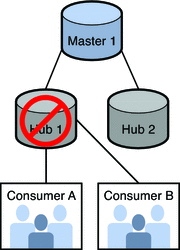Determining What to Reinitialize
When you reinitialize your topology, you take a good copy of the data from a supplier and overwrite the bad data on the consumers in the topology. Before you reinitialize your topology, determine which systems are unsynchronized and need to reinitialized. This critical step can prevent your from wasting time by overwriting data that is already synchronized.
For example, the following figure illustrates a topology where replication is broken on hub 1.

Because hub 1 provided data to consumers A and B, you need to reinitialize hub 1, consumer A, and consumer B.
In the following example, consumers A and B also receive updates from hub 2.

Consumers A and B may be synchronized with the supplier of the reinitialized replica because they receive updates from both hubs. Their status depends on which replica you select to reinitialize your topology. If you use RUVs to ensure that you have the latest changes, then these replicas may be up-to-date and you may not need to reinitialize consumers A and B.
- © 2010, Oracle Corporation and/or its affiliates
